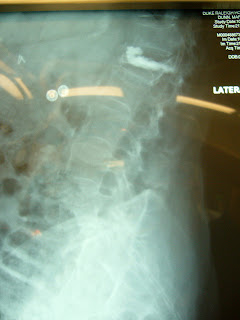This afternoon, we helped a 70 yo woman, who had a fall back in July with increasing back pain.
Her husband had been noticing some increasing kyphosis over past couple of years.
After the fall this July, she started to have severe debilitating back pain.
A week ago, she had vertebroplasty done for fracture at L1.
Her pain got worse, not better, and she was admitted to outside hospital where she was in so much pain, she could not even sit up.
Her studies showed an unstable burst fracture, with 50 percent canal compromise and evidence of toggling at that level. She also had severe thoracic kyphosis and lumbar scoliosis with severe osteoporosis.
Basically, what she really needed was a total spine replacement, which is not possible.
To fix this problem, a short fusion would not work, given her poor bone quality and deformities.
We were able to stabilize the fractures and improve her deformity by performing a T3-Iliac wing instrumentation and fusion, with L1 decompression.
Her surgery went very well, and took about 4 and a half hours.
Her family was very thankful.
She is doing well in ICU tonight.
Tomorrow, she can start to get up, now that her spine is stable.
Please be sure, whatever your age, that you take calcium with vitamin D every day.
It is a great investment to help prevent this type of pain and suffering in the long run.
Lloyd A Hey, MD MS
Hey Clinic for Scoliosis and Spine Surgery
Raleigh, NC USA
http://www.heyclinic.com
How can we care for scoliosis and kyphosis and spondylolisthesis better with conservative care like physical therapy, high-tech scoliosis braces, exercise and other techniques? What can be done to improve surgical care, and understand choices for surgery, learning from those around the world? How can we learn from aviation and from Deming's principles of "Standard Work" to constantly improve spine and all healthcare?
Subscribe to:
Post Comments (Atom)






No comments:
Post a Comment